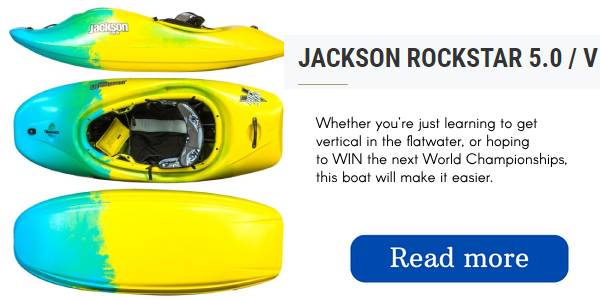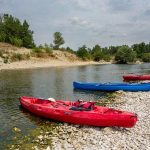When shopping for a whitewater kayak paddle, the most important thing to keep in mind is the size and shape of your kayak. This will help you determine which is the best paddle for you, to make the difference between making a difficult move and missing a stroke.
This you to know what to look for before you make your purchase.
Your paddle is an extension of your body and should feel natural. You should be able to feel the movement of the water through your paddle and make decisions based on the feedback you get from your hands.
Protection of one’s paddle is more important to many paddlers than their boat. This is because the paddle is more personal to them.
Factors to Consider
Before you can commit to your perfect paddle, you need to think about what sort of style you want to paddle with.
Playboating/Freestyle Kayaking
Playboating is a type of kayaking that involves doing tricks and dynamic moves. It typically happens on a wave, or in a hole where the water recirculates. The moves can include cartwheeling, looping, and pirouetting the kayak on end, all while remaining on the wave.
River Running
River running includes paddling downstream in a kayak and negotiating white water.
Steep Creeking
Steep creeking is a type of river running that features waterfall drops and tight lines. This is a highly technical discipline and often there is no room for mistakes.
Which Kayak Paddle Size Is Best?
Playboating/Freestyle Kayaking
The discipline of playboating requires a different kind of paddle than other disciplines due to the high stroke rate and the need for explosive power, which means you will want a shorter paddle with a large blade area.
Some companies have been making playboat paddles as short as 183 cm A shorter paddle will allow for a higher stroke turnover rate, also known as cadence. These shorter paddles are favored among playboaters. Playboat paddles tend to range from 191 cm to 197 cm. Some companies have been making playboat paddles as short as 183 cm.
River Running / Creeking
If you want to paddle more efficiently in a river, you’ll need a paddle that’s longer. This will give you a longer catch phase during your stroke, which is when you first generate power. Using fewer strokes will help you save time when you’re in a rapid.
The average length of a river running paddle is between 194 and 200 cm. These paddles are designed to help you paddle smoothly and efficiently for longer periods of time.
A high rate of paddle strokes and fast stroke recovery is necessary when surfing a wave or hole in order to be able to turn quickly and generate power in short bursts. These bursts of power give you the ability to generate upstream speed to stay on the face of the wave.
Blade Shape
The shaft of the paddle will curve away from the blade at the top, which gives your wrist a more comfortable grip. We won’t go into too much detail, but there are a few basics you should know about the different types of white water kayaking.
All white water kayak paddles should have asymmetrical blades in a rough teardrop shape. They will also be high-angle blades, which give you a stronger stroke and are better suited for the narrower style of kayak.
The shaft of the paddle will curve away from the blade at the top, which gives your wrist a more comfortable grip.
The blades on playboats have a more angled look, with a large area below the shaft. This shape provides a more immediate engagement and recovery phase, so your dynamic movements have more immediate power.
River paddles with longer blades generate more power because they have a better “catch” on the water. Keep this in mind when selecting the length of your paddle.
There is no one perfect paddle for everyone, so consider what kind of paddling you do the most when choosing a paddle. If you mostly playboat, you will want a different paddle than if you mostly river run.
Let’s say you have two paddles, each with the same blade surface area. The shapes of the blades might be different, but when the entire blade is submerged, an equal amount of surface area is in contact with the water.
Now imagine that only half the blade is going to be in contact with the water. If the blades are of different shapes, then the paddle’s blade position (horizontal or vertical in the water) will make a big difference in the effectiveness of the stroke.
Playboating Paddle Shape
The blade on these paddles is oriented horizontally, so your stroke is more efficient. It’s like taking lots of quick, short strokes with the shaft horizontal, as if you were catching a wave on the fly or trying to stay on a wave as it washes up to the top.
The blade hits the water horizontally and may or may not be completely submerged. In playboating, it’s often more important to get lots of little strokes in quickly, so the blade may not be completely in the water.
When the paddle is completely submerged, the whole surface area is effective. But when only half the paddle is submerged, this type of paddle outperforms one designed for a vertical axis.
River Running/Creek Boating Paddle Shape
Some paddles have a blade that is designed to be more efficient when it is on a vertical axis. This can be helpful when taking a stroke that is vertical, like a boof stroke, bow draw, or one or two strokes to get up to speed after being swirled on an eddy line.
If the blade hits the water when it is most of the way in, it will be more effective. However, often the water isn’t deep, or the stroke isn’t perfectly timed, so the blade doesn’t enter the water as much as it should.
In these cases, a paddle with a blade that is designed to be efficient on a vertical axis will work best.
What Are Kayak Paddles Made Of?
Since white water kayak paddles are constantly exposed to such harsh conditions, they need to be very durable in order to avoid breaking.
The paddle needs to be powerful and responsive, but also efficient and durable.
Aluminum
Though aluminum is heavy and less responsive than fiberglass, some recreational level white water paddles still use it. However, if you want to make progress, fiberglass is the better option.
Plastic
Many introductory white water paddles blades are made out of nylon. Plastic blades are more durable and can withstand hitting rocks better than other types of paddle blades. Most kayak schools around the world use plastic paddle blades.
The blades of these paddles are usually reinforced with fiberglass to make them more responsive and powerful. However, plastic blades always have some flex to them, which loses some power and limits feedback to the paddler.
Fiberglass
There are some other materials that are very popular but to a lesser extent. If you watch any major white water film, you will probably see the paddlers using fiberglass paddles. Fiberglass is the material most paddlers prefer for both the shaft and blades. Some other materials are used by some paddlers but to a much lesser extent.
Fiberglass shafts are not too stiff and not too flexible, so you get a good amount of feedback and response from them. They are also comfortable to use for long periods of time.
Fiberglass blades are used for the same purpose as carbon fiber blades. They are cheaper than carbon fiber blades, but they are still solid enough to withstand rocks. If you use your paddle a lot, the blades will slowly chip away and get smaller.
Fiberglass blades are powerful and providecatching speed and instant power with low flutter.
Carbon
The blades on carbon paddles are lighter and more responsive than those on fiberglass paddles, but they are also weaker. If you use them on rivers with a lot of rocks, they will deteriorate quickly.
Carbon blades with a foam or air core can help a paddle float above aerated water for extra power and a quicker Eskimo roll. However, if these are punctured, the paddle is useless.
The stiffness of a carbon shaft can be beneficial for some paddlers who want to maintain their power, but over time this can result in problems with the wrists. To alleviate this, many carbon shafts have the option to be bent, which will be explained later on.
Shaft Length
After your buddy slides the paddle through your hands, you should be positioned so that your hands are an equal distance from the blades, with your arms at a 90-degree angle. Your hands should be positioned about a fist’s distance from the blades.
If the paddle is too long or too short, consider adjusting the paddle’s length to better suit your needs. Also, keep in mind that if you are buying the paddle for playboating purposes, a slightly shorter shaft length can give you a faster swing rate for surfing.
The main advantage of using a wider stance with your arms at 90-degree angles is that it gives you a stronger, more efficient stroke by using your back muscles correctly, rather than just your biceps.
If the size you’re looking for is not listed on the website, it may be available as a custom order. Werner and AT generally only list sizes up to 200 on their websites, but we still sell a fair amount of 202 lengths to taller folks, so if you don’t see the size you want, ask about special ordering.
Shaft Size in Diameter
If your hand is 6.5″ – 7.5″ you should use their standard shaft, and if your hand is over 7.5″ then you should Probably use their large shaft. Some manufacturers offer different shaft sizes to make it easier to grip the paddle.
For example, Werner offers three different shaft sizes based on hand size. According to their sizing chart, if your hand measures 6.5 inches or less from the base of your palm to your fingertips, you should use the small shaft.
If your hand measures between 6.5 and 7.5 inches, you should use the standard shaft. If your hand measures more than 7.5 inches, you should use the large shaft.
If you are between 6.5 and 7.5 inches tall, you should try both the standard and the smaller diameter shafts. If you are taller than 7.5 inches, you should stay with the standard diameter. However, this is just a reference.
If you have the option to try out different shaft sizes, you should. I know several larger people who prefer the smaller shaft. The opposite can also be true. Below are two good reasons to test out some different shaft sizes:
- Sore hands, fingers, or elbows (often caused by gripping the paddle too hard) You may want to downsize if you don’t feel your hand going around the shaft with a solid grip… or you may want to upsize as it may be your hand is cramping because it is bending too much. I find the larger shaft keeps my hands more open which for me prevents me from griping as hard relieving my tendonitis and carpal tunnel (But you may find the opposite).
- Paddle slips out of your hands (may want to downsize for better grip)
Some kayak paddles have large shaft sizes, including A.T.’s bent shafts and Saltwoods regular shaft. These are both considerably bigger than other options and are worth trying before purchase.




